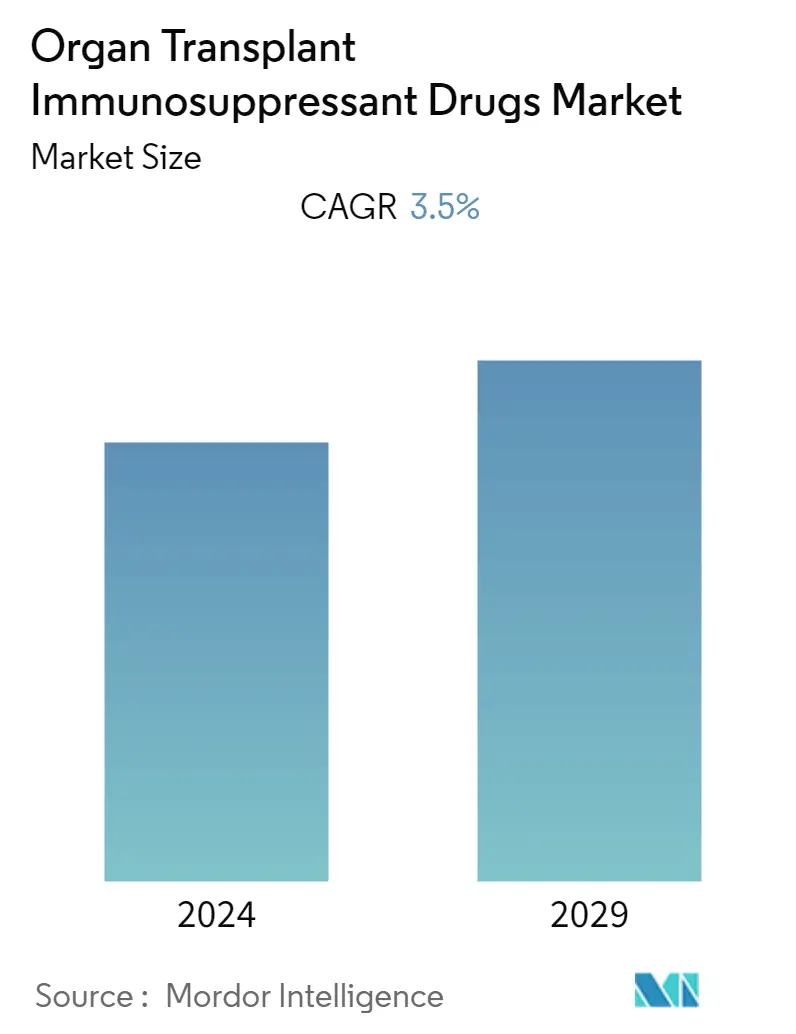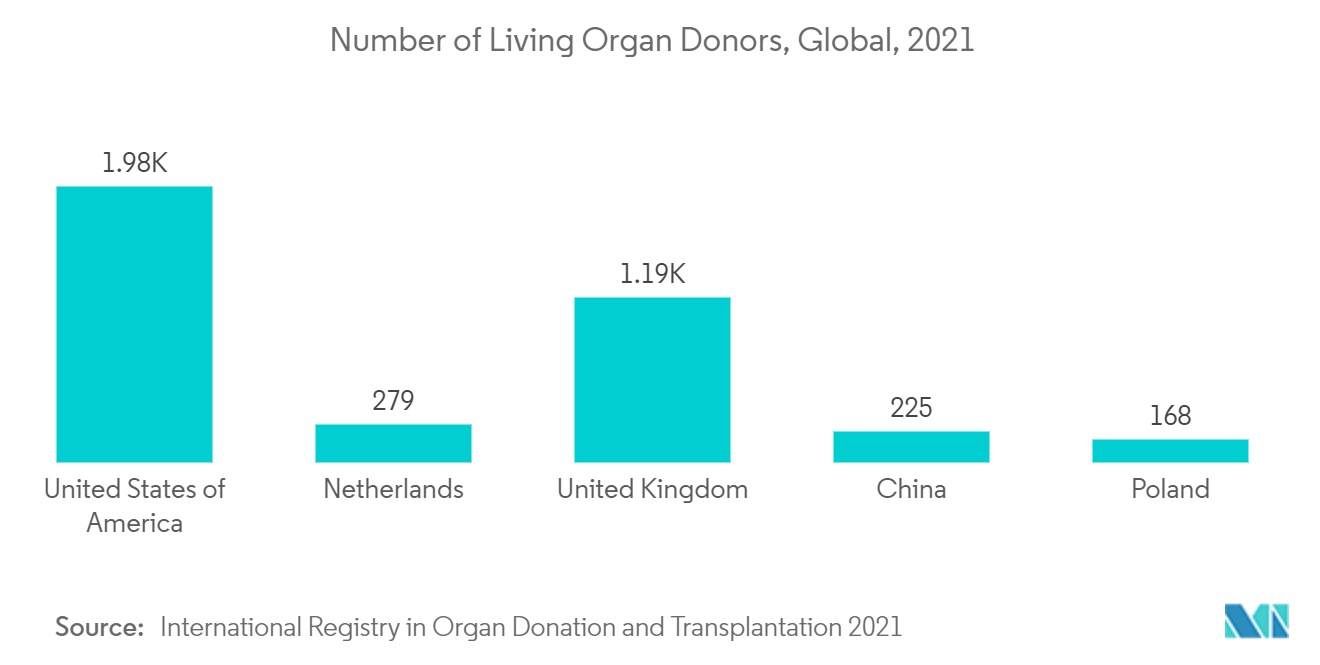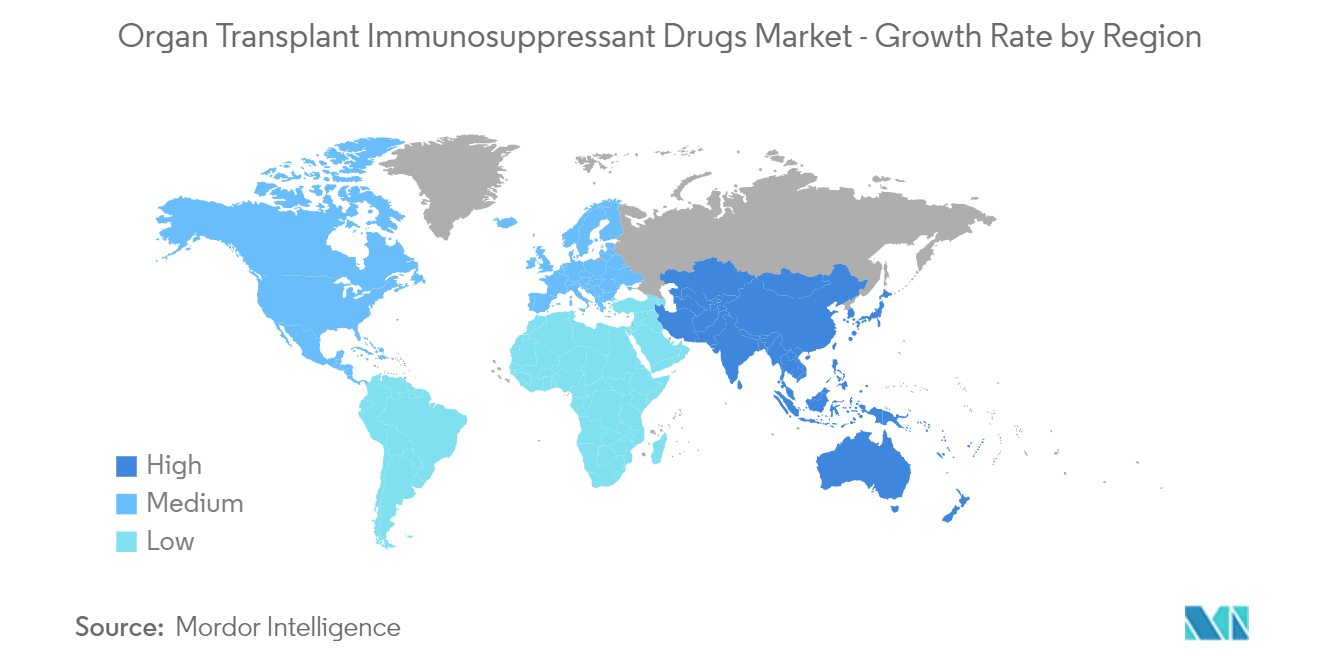Organ Transplant Immunosuppressant Drugs Market Size

| Study Period | 2019 - 2029 |
| Base Year For Estimation | 2023 |
| CAGR | 3.50 % |
| Fastest Growing Market | Asia Pacific |
| Largest Market | North America |
| Market Concentration | Low |
Major Players
*Disclaimer: Major Players sorted in no particular order |
Organ Transplant Immunosuppressant Drugs Market Analysis
The organ transplant immunosuppressant drugs market is expected to register a CAGR of 3.5% during the forecast period.
COVID-19 significantly impacted the organ transplant immunosuppressant drugs market in the initial phases since many surgeries associated with organ transplantation got delayed along with the shutdown and primary care centers. Due to the delay, there was an enormous increase in the number of transplant candidates on the waiting list, which made the procedure more complicated. However, since the restrictions were eased, the industry has been reviving strongly. Over the previous two years, the market recovery has been driven by an upsurge in increased organ transplantations and new immunosuppressant product launches.
The organ transplant immunosuppressant drugs market is likely to grow over the forecast period because of the rising incidence of chronic diseases and technological advancements in organ transplantation, as these factors can increase the availability of the product in the market, which is anticipated to have a positive impact on the market. For instance, as per the HRSA 2022 update, more than 40,000 transplants were performed in the United States in 2021. As per the same source, there are 105,842 people, including men, women, and children, on the national transplant waiting list. Additionally, government collaborations, the launch of organ transplant centers, and transplantation awareness programs conducted globally are likely to increase market growth as these can expand product availability and improve competition. For instance, in September 2022, an organ transplant center was established in the Middle East, Africa, in Cairo, in cooperation with international companies. This organ transplant center includes an automated database for transplants, patients, and donors. Hence due to such initiatives, high demand for organ transplantation is likely to adopt immunosuppressant drugs as there is an increased chance of immunity reactions when transplantation has occurred. Moreover, in September 2022, the central government of India officially accredited Karnataka's State Organ Tissue Transplant Organisation (SOTTO) to encourage organ donations in the state. It sanctioned a budget of INR 84 lakh (USD 101 thousand) for the program. As a result, the increased investment in the programs associated with organ donation is likely to drive market growth. Patients with financial issues can also have organ transplantation, boosting the growth of the organ transplant immunosuppressant drugs market.
Furthermore, as per the article published in Frontiers in 2021, solid organ transplantation is the treatment of choice for many patients with end-stage organ dysfunction. As per the analysis, the study demonstrated the effectiveness of Tregs in solid organ transplantation trials by examining their effects on chronic rejection, acute rejection, graft versus host disease, and other associated diseases. Such research conducted in organ transplantation is likely to boost market growth. A heart transplantation surgery is also chosen for people with heart problems who have not progressed sufficiently with drugs or previous operations. According to the 2022 update from Mayo Clinic, survival rates continue to improve despite an increase in older and higher-risk heart transplant recipients. Adults worldwide have a one-year survival rate of nearly 90% and a five-year survival rate of roughly 80%. Additionally, the high prevalence of cystic fibrosis is a major fuelling factor for market growth since a patient with advanced lung diseases along with cystic fibrosis is likely to undergo a lung transplant to improve their quality of life. For instance, according to the CFF 2022 update, there are nearly 40,000 people in the United States with cystic fibrosis. As a result, considering the opportunities for transplantation to improve disease conditions, the market is expected to rise rapidly throughout the forecast period.
Hence, as per the factors mentioned above, the organ transplant immunosuppressant drugs market is anticipated to witness growth over the forecast period. However, the high cost of transplantation and less availability of organs restrain the market growth.
Organ Transplant Immunosuppressant Drugs Market Trends
This section covers the major market trends shaping the Organ Transplant Immunosuppressant Drugs Market according to our research experts:
Calcineurin Inhibitors Segment is Expected to Hold a Major Market Share in the Market Over the Forecast Period
Calcineurin inhibitors are medicines that inhibit the action of calcineurin, an enzyme that activates T-cells of the immune system. These inhibitors exert their effects by reducing interleukin-2 production and receptor expression, reducing T-cell activation. Furthermore, they are essential for immunosuppression in solid organ transplantation. The calcineurin inhibitors segment is likely to witness growth over the forecast period since calcineurin inhibitors help improve the body's immune reactions after organ transplantation and are administered via oral, intravenous, topical, and ophthalmic routes.
The calcineurin Inhibitors segment holds a significant market share in the organ transplant immunosuppressant drugs market. It is anticipated to show a similar trend over the forecast period since it is effective and has been used in kidney transplant recipients for a long period. Calcineurin inhibitors (CNIs) represent the foundation of renal transplant immunosuppression. The two medicines comprising this therapeutic class, cyclosporine A (CSA) and tacrolimus (TAC), have been used in kidney transplant recipients for over 20 years. As per the article published in PubMed journal in April 2022, calcineurin inhibitors are safe to administer to patients and do not cause any fatal outcomes in kidney transplant recipients.
Moreover, the rising incidence of kidney failures and liver damage, which is expected to increase the demand for kidney and liver transplantation, and technological advancements in organ transplantations are the key driving factors in the calcineurin inhibitors segment. For instance, as per the IRODAT 2021 report, the number of kidney transplants from living donors was 1,803 in the United States, whereas, in Norway, the transplantation count was 1,237. As per the same source, the number of liver transplants from living donors was 1,632 in Turkey, whereas, in Saudi Arabia, the transplantation count was 1,013.
Hence, the chance of utilizing the immunosuppressant medication after the transplant is likely to increase. Therefore, the market is expected to grow in the calcineurin segment over the forecast period.

North America is Expected to Hold a Significant Share in the Market and Expected to do Same in the Forecast Period
North America is expected to hold a major market share in the global organ transplant immunosuppressant drugs market due to the high number of transplant procedures, the increasing prevalence of chronic ailments requiring organ transplants, and favorable reimbursement policies in this region. For instance, according to the CDC 2022 update, in the United States, the most transplanted organs are the kidney, liver, heart, lungs, pancreas, and intestines. On any given day, there are around 100,000 people on the active waiting list for organs, but only approximately 14,000 deceased organ donors in 2021, with each providing, on average, 3.5 organs. As per the same source in the United States, the most transplanted tissues are bones, tendons, ligaments, skin, heart valves, blood vessels, and corneas. Around 3.3 million tissue grafts were distributed each year. About 2.5 million grafts were transplanted.
Furthermore, as per the IRODAT 2021 report, in 2021, the number of organ transplants from living donors in Mexico was 1,158. Hence due to the increase in organ transplantation in Mexico, there is a high chance of taking immunosuppressant medication after the liver transplantation surgery. Therefore, the organ transplant immunosuppressant drugs market is likely to grow in the studied region. Additionally, as per the CIHI report, as of December 31, 2021, 4,043 Canadians were on wait lists to receive a transplant, 57% were active on the waiting list, and 43% were on hold due to a medical or other reason for a short period. According to the same source, for every transplant in Canada in 2021, approximately 1.5 patients were waiting to receive an organ. For each organ-specific transplant that occurred, 2.3 patients were waiting for a pancreas, 1.8 were waiting for a kidney, one was waiting for a heart, and less than one was waiting for a liver or a lung. Hence, the higher rates of organ transplantation in Canada are also driving the market growth in the North American region over the forecast period.
Furthermore, technological advancements in tissue engineering and organ transplantations, increasing healthcare spending, and the presence of well-established healthcare infrastructure are fueling the growth of the overall regional market to a large extent. Additionally, the data updated by the USFDA published in November 2021 showed that there were 4,944 FDA-registered facilities for biologics developments and 6,799 for human drugs. Such a high number of manufacturing facilities to produce drugs is expected to create opportunities for utilizing the organ transplant immunosuppressant drugs market and drive market growth in the studied region.
Hence considering the above-mentioned factors, North America is likely to witness growth over the forecast period.

Organ Transplant Immunosuppressant Drugs Industry Overview
The organ transplant immunosuppressant drugs market is fragmented, competitive, and consists of several major players. In terms of market share, a few of the major players are currently dominating the market. Some of the companies, which are currently dominating the market, are Astellas Pharma Inc., Sanofi, Bristol-Myers Squibb Company, Novartis AG, F. Hoffmann-La Roche Ltd, GSK PLC, Accord Healthcare Ltd Inc., Dr. Reddy's Laboratories Ltd, and Veloxis Pharmaceuticals A/S.
Organ Transplant Immunosuppressant Drugs Market Leaders
-
Astellas Pharma, Inc
-
Bristol-Myers Squibb Company
-
Novartis AG
-
Sanofi
-
F. Hoffmann-La Roche Ltd
*Disclaimer: Major Players sorted in no particular order

Organ Transplant Immunosuppressant Drugs Market News
- In August 2022, the India-based Concord Biotech Limited, one of the developers and manufacturers of select fermentation-based APIs across immunosuppressants and oncology in terms of market share, based on volume in 2021, filed its Draft Red Herring Prospectus (DRHP) with the markets regulator, Securities, and Exchange Board of India (SEBI), to raise funds through an initial public offering (IPO).
- In August 2022, Strides received USFDA approval for its Cyclosporine Softgel Capsules. Strides further established its position in the market with the addition of Tacrolimus capsules, Cyclosporine Softgel capsules, and Mycophenolate Mofetil tablets and capsules to its immunosuppressant product portfolio for the US market.
Organ Transplant Immunosuppressant Drugs Market Report - Table of Contents
1. INTRODUCTION
- 1.1 Study Assumptions and Market Definition
- 1.2 Scope of the Study
2. RESEARCH METHODOLOGY
3. EXECUTIVE SUMMARY
4. MARKET DYNAMICS
- 4.1 Market Overview
-
4.2 Market Drivers
- 4.2.1 Increasing Number of Organ Transplants Due to Chronic Diseases
- 4.2.2 Technological Advancements in Tissue Engineering and Organ Transplantations
-
4.3 Market Restraints
- 4.3.1 High Cost of Transplantation
- 4.3.2 Low Availability of Organs
-
4.4 Porter's Five Force Analysis
- 4.4.1 Threat of New Entrants
- 4.4.2 Bargaining Power of Buyers/Consumers
- 4.4.3 Bargaining Power of Suppliers
- 4.4.4 Threat of Substitute Products
- 4.4.5 Intensity of Competitive Rivalry
5. MARKET SEGMENTATION (Market Size by Value - USD Million)
-
5.1 By Drug Class
- 5.1.1 Calcineurin Inhibitors
- 5.1.2 Antiproliferative Agents
- 5.1.3 mTOR Inhibitor
- 5.1.4 Steroids
- 5.1.5 Others Drug Classes
-
5.2 By Transplant Type
- 5.2.1 Heart
- 5.2.2 Kidney
- 5.2.3 Liver
- 5.2.4 Lung
- 5.2.5 Pancreas
- 5.2.6 Other Transplant Types
-
5.3 Geography
- 5.3.1 North America
- 5.3.1.1 United States
- 5.3.1.2 Canada
- 5.3.1.3 Mexico
- 5.3.2 Europe
- 5.3.2.1 Germany
- 5.3.2.2 United Kingdom
- 5.3.2.3 France
- 5.3.2.4 Italy
- 5.3.2.5 Spain
- 5.3.2.6 Rest of Europe
- 5.3.3 Asia-Pacific
- 5.3.3.1 China
- 5.3.3.2 Japan
- 5.3.3.3 India
- 5.3.3.4 Australia
- 5.3.3.5 South Korea
- 5.3.3.6 Rest of Asia-Pacific
- 5.3.4 Middle East and Africa
- 5.3.4.1 GCC
- 5.3.4.2 South Africa
- 5.3.4.3 Rest of Middle East and Africa
- 5.3.5 South America
- 5.3.5.1 Brazil
- 5.3.5.2 Argentina
- 5.3.5.3 Rest of South America
6. COMPETITIVE LANDSCAPE
-
6.1 Company Profiles
- 6.1.1 Astellas Pharma Inc.
- 6.1.2 Sanofi
- 6.1.3 Bristol-Myers Squibb Company
- 6.1.4 Novartis AG
- 6.1.5 F. Hoffmann-La Roche Ltd
- 6.1.6 GSK plc
- 6.1.7 Accord Healthcare Ltd
- 6.1.8 Viatris
- 6.1.9 Dr. Reddy's Laboratories Ltd
- 6.1.10 Veloxis Pharmaceuticals A/S
- *List Not Exhaustive
7. MARKET OPPORTUNITIES AND FUTURE TRENDS
** Subject To AvailablityOrgan Transplant Immunosuppressant Drugs Industry Segmentation
As per the scope of the report, immunosuppressants or anti-rejection drugs are the categories of drugs that lower the body's ability to reject a transplanted organ. The organ transplant immunosuppressant drugs market is segmented By Drug Class (Calcineurin Inhibitors, Antiproliferative Agents, mTOR Inhibitor, Steroids, and Other Drug Classes), Transplant Type (Heart, Kidney, Liver, Lung, Pancreas, and Other Transplant Types), and Geography (North America, Europe, Asia-Pacific, Middle East and Africa, and South America). The market report also covers the estimated market sizes and trends for 17 different countries across major regions globally. The report offers the value (in USD million) for the above segments.
| By Drug Class | Calcineurin Inhibitors | |
| Antiproliferative Agents | ||
| mTOR Inhibitor | ||
| Steroids | ||
| Others Drug Classes | ||
| By Transplant Type | Heart | |
| Kidney | ||
| Liver | ||
| Lung | ||
| Pancreas | ||
| Other Transplant Types | ||
| Geography | North America | United States |
| Canada | ||
| Mexico | ||
| Geography | Europe | Germany |
| United Kingdom | ||
| France | ||
| Italy | ||
| Spain | ||
| Rest of Europe | ||
| Geography | Asia-Pacific | China |
| Japan | ||
| India | ||
| Australia | ||
| South Korea | ||
| Rest of Asia-Pacific | ||
| Geography | Middle East and Africa | GCC |
| South Africa | ||
| Rest of Middle East and Africa | ||
| Geography | South America | Brazil |
| Argentina | ||
| Rest of South America |
Organ Transplant Immunosuppressant Drugs Market Research FAQs
What is the current Organ Transplant Immunosuppressant Drugs Market size?
The Organ Transplant Immunosuppressant Drugs Market is projected to register a CAGR of 3.5% during the forecast period (2024-2029)
Who are the key players in Organ Transplant Immunosuppressant Drugs Market?
Astellas Pharma, Inc, Bristol-Myers Squibb Company, Novartis AG, Sanofi and F. Hoffmann-La Roche Ltd are the major companies operating in the Organ Transplant Immunosuppressant Drugs Market.
Which is the fastest growing region in Organ Transplant Immunosuppressant Drugs Market?
Asia Pacific is estimated to grow at the highest CAGR over the forecast period (2024-2029).
Which region has the biggest share in Organ Transplant Immunosuppressant Drugs Market?
In 2024, the North America accounts for the largest market share in Organ Transplant Immunosuppressant Drugs Market.
What years does this Organ Transplant Immunosuppressant Drugs Market cover?
The report covers the Organ Transplant Immunosuppressant Drugs Market historical market size for years: 2019, 2020, 2021, 2022 and 2023. The report also forecasts the Organ Transplant Immunosuppressant Drugs Market size for years: 2024, 2025, 2026, 2027, 2028 and 2029.
Organ Transplant Immunosuppressant Drugs Industry Report
Statistics for the 2024 Organ Transplant Immunosuppressant Drugs market share, size and revenue growth rate, created by Mordor Intelligence™ Industry Reports. Organ Transplant Immunosuppressant Drugs analysis includes a market forecast outlook to 2029 and historical overview. Get a sample of this industry analysis as a free report PDF download.



